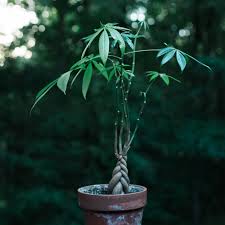Money trees, or Pachira aquatica, are popular for their distinctive “braided” trunk and graceful, oblong leaves.
Money tree care is also easy! They stay at a manageable size indoors but can grow up to 60 feet tall in their native habitat in Central and South America.
Many consider these trees to be luck and bring financial success, and they’re very popular with feng shui practitioners because they sprout five leaves at the end of each stem. (Five is an important number in feng shui.) Isn’t that cool?
Here’s how to care for a money tree of your own!
Table of Contents
Everything You Need to Know About Money Tree Care
Light
Money trees prefer bright, indirect sunlight. Place them near a sunny window but not directly in the sun’s rays. They also do well in slightly lower light, so don’t stress if you don’t have the absolute perfect place for it.
It’s also a good idea to rotate your plant with every watering so the leaves all get a little light.
Humidity
These plants grow in tropical wetlands, so they LOVE humidity. Keep them away from heating/cooling vents and space heaters. You may also want to keep a humidifier in the room where your money tree lives or place it on a pebble tray.
To make a pebble tray, simply fill a shallow tray with pebbles and water and sit the plant on top. Don’t let the roots or soil touch the water.
Temperature
Money trees do NOT like to be cold, so keep them well away from drafts. Otherwise, they may drop their leaves. 65-80 degrees is their happy place.
Soil and Potting
Choose a fairly sandy, peaty soil for your money tree. Make sure your pot drains well. Avoid using a pot that’s a lot bigger than the root ball because this can hold onto way more water than the money tree needs, which can lead to root rot.
Try mixing a little peat moss and sand or perlite to indoor potting mix for a fast-draining money tree soil.
Money trees only need to be repotted every 2-3 years.
Water
Let the top 2-4 inches of your money tree’s soil dry out in between waterings, but don’t let it go very long in this state. When it’s time to water, add water to the soil until it starts to drain out the bottom, then empty the drainage tray immediately.
For best results, let tap water sit out overnight before watering your plant so chlorine and any other chemicals can dissipate. You can also use distilled water.
Fertilizer
Fertilize once per month during the spring and summer when the plant naturally grows. You don’t have to fertilize in the winter. I love Indoor Plant Food because it contains all the right nutrients for all my houseplants, and it’s easy to use!
Common Problems:
Root rot
This occurs when the plant is overwatered or when the pot/soil doesn’t drain well enough. The leaves might turn yellow or drop, and you may notice brown, squishy stems.
If this happens, repot the plant into fresh soil and a clean pot. (You can use the old pot, just make sure to wash it thoroughly.) Rinse the oil soil off the roots and trim off any soft, smelly roots.
Go a little easier on the water as your plant heals. I also highly recommend our Root Rot Treatment to help your plant recover and regrow healthy roots!
Leaf Scorching
This happens when your money tree gets too much sun! You might notice browning on the ends of the leaves.
Lack of Light
You might notice yellowing leaves if your money tree doesn’t get enough light, even if your plant isn’t overwatered.
Insects
Like many houseplants, money trees are susceptible to common pests like mealybugs and scale. Leaf Armor can protect against insects and other leaf problems. Check it out here!
Other Tips:
- Money trees don’t like to be moved often, so expect to lose a few leaves if you decide to move it.
- Money trees are safe for pets, so this is a good plant to try if you have furry friends around.
- Every spring, prune your money tree to help it maintain its shape. Use a sharp, clean tool to remove any brown or dying leaves, stems, or any pieces that are overgrown.
- Most nurseries braid the trunks of the money tree while they’re still green stems. You can also train the trunk by wrapping string or twist ties around the stems so they’ll grow where you want them to! Be gentle with the stems and don’t force them to bend too far, or you can do irreparable damage to the plant.
- Money trees are easy to find! Your local home improvement store or nursery should carry them, and you can also find them online.
Whether you can use a little luck in your life or you’re a fan of beautiful indoor plants, a money tree is a great choice. It’s gorgeous and relatively easy to care for, with only modest watering and sunlight needs.
Give it a try!





